Karelia #1 (Photography hide and Koli)
I rented a car and headed east towards the Lieksa area in Karelia. Karelia was a former Finnish province that is now divided between Finland and Russia. My goal was to spend two days in a photography hide near Hattuvaara. A local company (Era Eero) rents a number of photography hides both in the forest and near a small pond. The accommodations in the hides are plain, bunk bed, dry toilet (think human litter box), multiple ports for your camera, and you’re required to stay in the hides from 2 pm until 8 am. The hides have propane heaters, although I decided to forego using one and relied on a sleeping bag instead (both nights were chilly – we had rain the second evening).

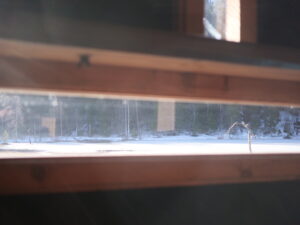
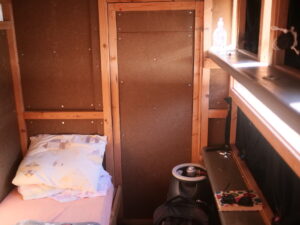
The area has wolverines, wolves, and bears. There is one bear sow with three cubs that have been frequenting the area. Since I’ve seen bears on multiple occasions I decided to focus my visit on wolverines. The company has permission from Finnish authorities (fish and game veterinarians) to feed wildlife. Despite using some food as an attractant it can remain hit and miss as to whether it draws animals closer to the hides. The number of wolverine and bear sightings in the area have been down this past Spring. Fewer wolf (they tend to be more solo hunters here in this region) and moose sightings as well. It’s not clear whether the late Spring may be having an effect. Several photographers were in a second set of hides near the forest (I was near the pond) in the hopes of photographing the bear cubs. The bears did arrive each night around midnight so although they were able to see them they were unable to obtain decent photographs.
I found the 18 hours of solitude enjoyable. No one else was within miles of my location. Once you remove the cacophony of background noise we live with on a daily basis you begin to realize the sounds that nature provides are drowned out by our manmade noise. I could even hear wingbeats as the birds flew past the hide. The last morning became colder as the sun rose and I could see ice slowly reforming on the pond. Since most of the time in the hide is spent quietly waiting for animals to appear I focused my attention on other wildlife. Several species of ducks arrived in the evenings including teals (right) and mallards (left).
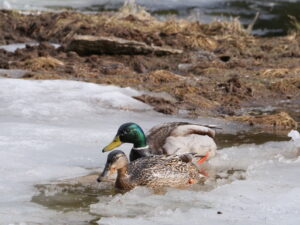
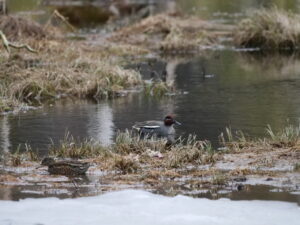
The white wagtails were active throughout the day.
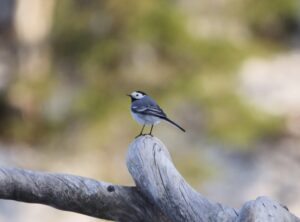
On the drive over I saw a curlew with a slightly curved beak
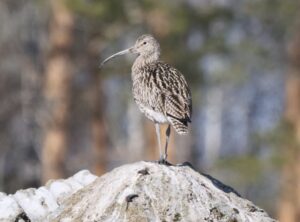
While at the photography hide I also saw ‘sandpipers’. Their beaks are straighter than the curlews and based on their reported distributions, habitat, and eyebrow stripe I think these are possibly wood sandpipers although they may also be greenshanks (another member of the sandpiper family). I still need to look more closely at my photos to identify them.
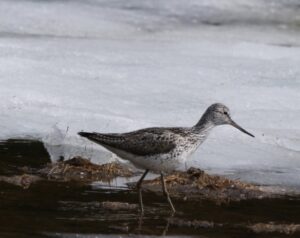
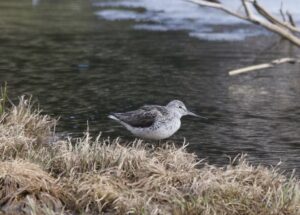
The most common animals by far were gulls. They were quite active – the two main species in the area were common gulls (middle and right( and great black backed gulls (left). There may have been a third species of gull that I am trying to identify. All of the gulls were noisy and had quite the vocal range of calls. I drew a strong appreciation for how annoying the gulls are. The black backed gulls in particular proved to be the local bully and they often chased off ducks and other birds. There are always bigger bullies in life and that turned out to be the ravens which seemed to be constantly circling the pond looking for a fight with the gulls. The ravens often lost since they were clearly outnumbered.
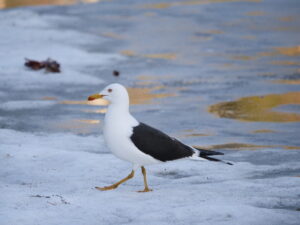

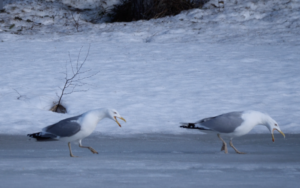
Eurasian blackbirds would make brief appearances in the early morning and towards evening.

At night I heard the occasional owl (it may have been a boreal owl based on the call) and once or twice woodpeckers in the morning. There is one bird that called during the night that I remain hopeful I can identify (it made loud paired calls). One golden eagle flew nearby but it was a very fleeting sighting. The positioning of the hides made it difficult to photograph birds in flight and each day was somewhat overcast muting the available light for photographs.
When I left Hattuvaara on Sunday morning, I traveled around lake Pielinen to visit Koli which is a relatively large hill by Finnish standards. The highest mountains in Finland are located in Lapland. The tallest summit in Finland is on Ridnitšohkka (elevation 1317 m/4320 feet) near the Norwegian and Finnish border. Koli is on the western side of Pielinen which is the fourth largest lake in Finland. The Koli hills rise to about 354 m (~1160 feet) and provide panoramic views of Pielinen and the surrounding area. This is a famous location for Finnish landscape painters and photographers. There is a small hotel near the top of Koli and the ski slopes had snow but were closed for the winter. The Koli hills are protected by Koli National Park which was established in 1991.
This region of Karelia (and much of Finland) is reminiscent of the upper midwest especially Minnesota (the “Land of 10,000 Lakes”). The lakes here are more numerous and tend to be larger. Although Lake Saimaa here in Finland and Red Lake in Minnesota are virtually identical in size (443 versus 440 square miles per Encyclopedia Britannica) it connects with other lakes forming extensive lake systems that dwarf those found in the upper midwest. The US and Canada instead have the Great Lakes that were created at about the same time. Lake Superior is nearly 40% the size of all of Finland. The day I visited Koli was bright and clear. The stairs leading to the summit were blocked by mounds of snow and ice so I relied on the view from the hotel balcony instead.
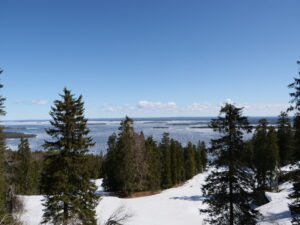
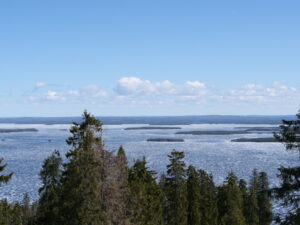
That’s it for now. Check out the next blog for photos of the main visitors to the hide…
- Categories: